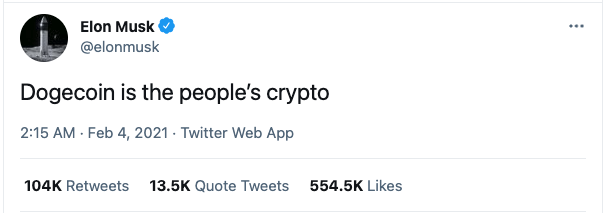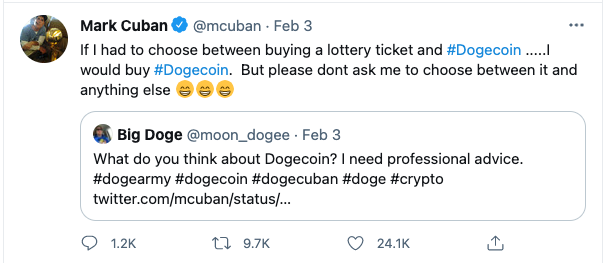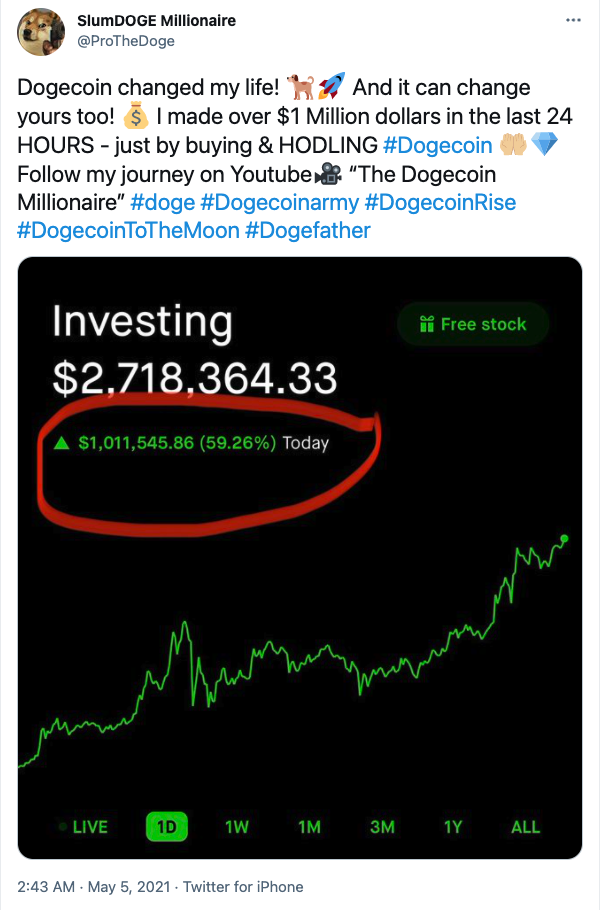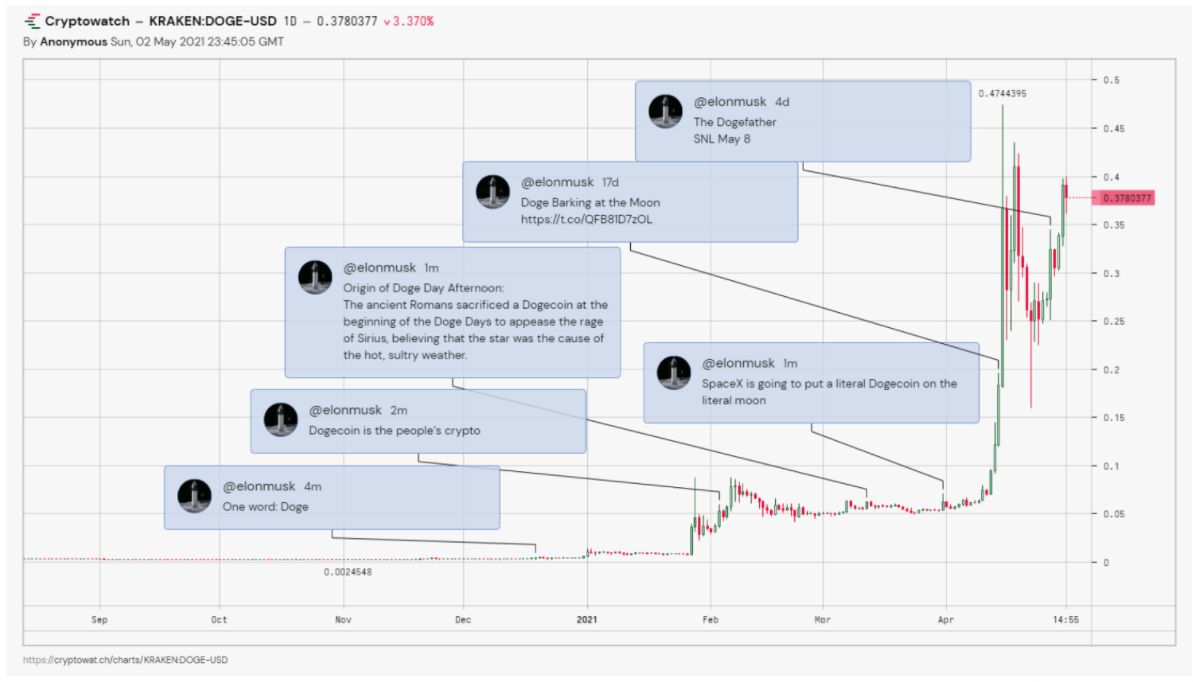“I’m just a dude,” Jasyn Prolifiq said. Prolifiq is 33 years old and lives in Los Angeles. He works a 9–5 making YouTube videos for an online hip-hop magazine, he loves his family, and on April 15 he became a dogecoin millionaire.
Prolifiq first got into investing a few years ago when he bought his first Tesla stock. He’s always been a saver, resisting the urge to replace his 2004 Toyota Corolla that’s falling apart. “The mirror on the side is broken and every time I try to superglue it, it just melts down the side of the door.”
He first got into dogecoin after watching r/WallStreetBets traders initiate the epic short squeeze in GameStop’s stock this winter. But Prolifiq wanted to invest in something that wouldn’t be subject to regulations or possible hedge fund involvement—something that was “a whole different world,” he told Morning Brew.
So he maxed out two credit cards, borrowed money from family and friends, and put his entire life savings into dogecoin through the Robinhood app. On February 5, 2021, Prolifiq said he invested ~$180,000 into the meme stock when it was less than $0.05, and on April 15, exactly 69 days later—an important number in the doge community because of…well…the cultural significance—he broke $1 million in holdings.
How’d he get there?
January 28: When Robinhood and other trading platforms started restricting GameStop (GME) orders due to liquidity issues, r/SatoshiStreetBets, a crypto investing group on Reddit, tried to harness the investing enthusiasm that had propelled meme stocks to make dogecoin the next GameStop. At 5:47pm ET the same day, Elon Musk tweeted a photo of a fake Vogue cover with the title “Dogue” to show his support for the crypto. The coin jumped from $0.007 on January 27 to $0.05 on January 29, per Coinbase.
February 4: Elon Musk tweeted that “dogecoin is the people’s crypto” and posted a photoshopped image of him and doge.


February 7: By 6:59pm ET dogecoin hit $0.08.
April 15: Dogecoin hit $0.29 and Prolifiq became a paper millionaire. By April 16, thanks in part to more Elon Musk and Mark Cuban tweets about doge, the coin reached a market value of >$48 billion.
May 5: In the early hours, Prolifiq hit $2.7 million. As of Wednesday morning, dogecoin hit $0.65, up 13,960.31% YTD and close to its $0.69 all-time high, per CoinDesk.

What is dogecoin?
Dogecoin was created by software engineers Billy Markus and Jackson Palmer in 2013 as a combo of two of the internet’s favorite things: the popular 2013 Shiba Inu meme known as “doge” and cryptocurrency. In 2013, Palmer tweeted as a joke, “Investing in dogecoin, pretty sure it’s the next big thing.” People replied to his tweet encouraging him to make it happen, and he committed to the bit, buying the domain dogecoin.com.
Within a couple of days of the site going live, Markus, who had never met Palmer, discovered the site and reached out to see if Palmer wanted to turn dogecoin from a tweet into a tangible token. They never thought what they were really doing was turning a bit into a multi-billion dollar market cap. Before reaching out, Markus had already tried creating his own altcoin called “Bells,” based on the Animal Crossing currency, but didn’t have much luck.
Eventually, the two joined forces, and a little over a week from when Palmer first jokingly tweeted about investing in dogecoin, the coin had a fair launch with no presale, pre-mine, or VC fundraising, just like bitcoin.
Dogecoin was created as a parody of other “altcoins”—cryptocurrencies other than bitcoin—that had intensely loyal communities, were difficult to invest in, and all about getting rich and hoarding digital assets.
It was a hit. Redditers took to dogecoin like paparazzi to Ben Affleck holding lots of things, forming the subreddit r/dogecoin almost immediately. In 2014, the online dogecoin community raised money to send the Jamaican bobsled team to the winter Olympics and donated $25,000 to a charity that trains service dogs for children with disabilities and veterans.
Elon Musk enters the chat. The second richest man in the world has been a crypto pioneer since traditional finance guys like Jamie Dimon were calling it a fraud in 2017. Musk was even voted on Twitter as the “CEO of dogecoin” in 2019 and said it was his favorite crypto.
“It’s his crypto, even though it’s not…it might as well be,” Prolifiq told Morning Brew. The r/dogecoin has 1.7 million subshibers (nice) who constantly share Musk rumors, like discussing whether he’s getting a Shiba Inu puppy or if Tesla will start accepting dogecoin. Some of Musk’s tweets can be linked directly to dogecoin spikes.

Cryptowat.ch
And what makes it different than Bitcoin? Dogecoin is bitcoin’s weird granddaughter who loves giving hugs and calling everything “lit.” Bitcoin is an open-source project, so anyone can use the source code to create their own altcoin. Here’s the evolution of dogecoin, each arrow represents a codebase fork, or when code is copied and slightly tweaked to form a new coin: bitcoin→litecoin→junkcoin→luckycoin→dogecoin
The biggest change from bitcoin to litecoin (and all the coins after) was the use of scrypt technology which was designed to prevent specialized bitcoin mining equipment from also mining litecoins. In late 2014, dogecoin got forked up and became merge-mined with litecoin which just means that litecoin miners can also mine dogecoin at the same time with no extra cost
Dogecoin, like bitcoin, has no intrinsic value, but unlike bitcoin, dogecoin doesn’t have a supply cap. So while there will be a limited number of bitcoins floating around (21 million), there could theoretically be an infinite amount of dogecoins.
Welcome to the dark side
It’s not all fluffy dogs and “much wow” for dogecoin. Like most crypto, its price is extremely volatile. And the same low-barrier for entry that allowed a lot of beginner crypto traders to buy dogecoin also brought in the scammers.
- The biggest scam went down six years ago when Alex Green (real name Ryan Kennedy) stole ~$4 million worth of cryptocurrency by convincing dogecoin investors to use his exchange platform called Moolah.
- The very first hack happened less than 20 days after dogecoin was launched when ~21 million dogecoins (~$12,000 at the time) were stolen from dogewallet, an app to store and exchange the crypto. That’d be worth about $13 million in today’s dogecoin price.
Pump-and-dump schemes became common in the early years of dogecoin, and even bigtime crypto investors warn that the coin’s volatility and lack of utility don’t bode well for the future. Michael Novogratz, CEO of crypto investment firm Galaxy Investment Partners, told Bloomberg, “I would be very, very worried if one of my friends was investing in dogecoin at these prices.”
Dogecoin also lacks infrastructure and development, says Galaxy Digital Research in its recent report. While it’s one of the oldest cryptos on the market (a year-and-a-half older than Ethereum), it hasn’t seen much real development compared to Bitcoin’s bustling ecosystem.
But prices, at least in the short term, have only kept going up. How can we explain this?
Everything about dogecoin encapsulates today’s extremely online, meme-driven era that often escapes traditional investors’ understanding. It’s got a real “everything is made up and the points don’t matter” vibe that younger millennials and Gen-Zers have come to embrace when it comes to culture or the stock market.
Right before the pandemic hit, Prolifiq tried to buy a house. He’d saved up $130,000, but when he applied for a loan, he couldn’t get one because he didn’t have enough credit. “I’d never made a big purchase in my life. There was one day I remember being on the phone with my mom and I was in tears because I busted my whole life for this.”
Young people are feeling weighed down by higher costs for everything from housing to tuition. At one point, dogecoin represented a way to laugh it all off. And to some early doge holders, it probably still retains that meaning. But others could care less—with prices skyrocketing, it’s just a way to make a quick buck.
The moment you’ve all been waiting for…
What is Jasyn Prolifiq, the dogecoin millionaire, going to do with his money?
To avoid short-term capital gains taxes, he doesn’t plan to touch the money for at least a year. He’s betting on dogecoin in the long term and believes someday you’ll be able to pay for haircuts, buy McDonald’s, or purchase goods on Amazon with the meme coin.
While he waits for his portfolio to hit $1 billion, he plans to make some extra cash the old fashioned way: branding. He’s already bought the web domain www.thedogecoinmillionaire.com and snagged “thedogecoinmillionaire” handles on YouTube, Twitter, Instagram, and TikTok. He’s planning to start releasing YouTube videos and social content consistently. He also hopes to make merch and start working with brands that are excited about dogecoin.
It was only a matter of time. Tech e-retailer Newegg, Latvian airline airBaltic, and the Dallas Mavericks have started accepting dogecoin as payment. And other brands tired of dragging customers on Twitter as their only marketing strategy have also leaned into the trendy dogecoin:
- In celebration of Doge Day on April 20, SlimJim auctioned off its first-ever NFT called Rocket Stick Special Edition. The company behind your mom’s “no meat sticks in the car” rule donated $17,000 from the Long boi Gang (marketers are absolutely doing the work with this) to World Central Kitchen.
Prolifiq remains bullish about the crypto, but with his content side hustle, he’s preparing for life whether dogecoin goes to the moon or burns up before it reaches orbit.
“The longer I hold, the more I can create content on top of all of this, even if it goes down, guess what? That’s content. People want to see me lose a hundred thousand dollars,” he said. Eventually, he wants to start a record label, buy his mom a house, and, “Once Tesla accepts dogecoin, I’m buying my first Tesla.”
